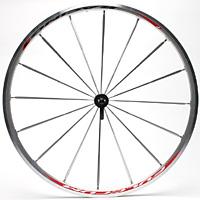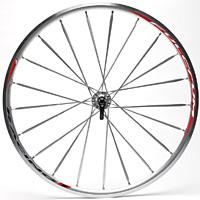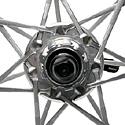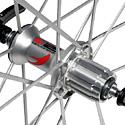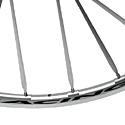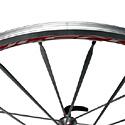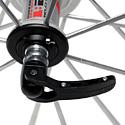
Recently on Cyclingnews.com |
On test: Fulcrum Racing 1 wheels, September 20, 2005
Fast & sleek
A 'new' player in the wheels arena has arrived with an instant hit - which given its parentage is not too surprising, says John Kenny.
|
|
|
There is no mention of a parent company on Fulcrum's website, but it is no secret that the Italian component giant, Campagnolo, is the real technical power behind these wheels. This situation demands the question: why would one of the biggest players in the bicycle industry, with a long-established reputation for producing desirable components, feel the need to market under the name of a subsidiary?
At least part of the answer must lie with the success of wheels such as Mavic Ksyriums, which these Fulcrum Racing 1s resemble quite a bit. Mavic's wheels have a major advantage over Campagnolo's in that buyers don't necessarily feel that they are disturbing the continuity of their groupsets by using Mavic wheels.
Some riders using a full Shimano Dura-Ace group, for example, might feel that mixing their components with Campagnolo wheels would be akin to pollution. (Campagnolo users don't have the option because Shimano doesn't make Campagnolo-compatible wheels.) After all, the finicky reputation of cyclists has some foundation in fact, so it's a shrewd marketing move on Campag's part to use a different brand to counter this reality.
Pro sponsorship
The relationship with Campagnolo also explains why a 'new' wheel manufacturer has been able to almost instantly secure the sponsorship of three of Europe's biggest pro teams: Quickstep, Saunier Duval-Prodir and Panaria-Navigare. All three teams are supplied with Fulcrum Racing 1 wheels.
Fulcrum's access to Italian superstar Paolo Bettini almost immediately provided the manufacturer with valuable exposure. Stage wins and days spent in the maglia rosa of Giro d'Italia leader are invaluable currency for a new player trying to gain acceptance in a crowded marketplace. Four stages were won on Fulcrum's Racing 1 wheels in the 2005 Giro.
Line-up
The Racing 1 wheels on test are the top-of-the-line offering from the Italian manufacturer. Racing 3 and Racing 5 complete the line-up. We don't know wjhat happened to numbers 2 and 4 - perhaps they will come later if the range proves to be a success.
Design features
|
|
|
|
|
|
|
|
|
|
|
|
|
Despite the similarities with the Mavic Ksyrium, there are some design changes that make the wheels stand out. The most obvious difference is found at the hub. The heads of the straight-pull spokes are neatly hidden inside the hub body on the Fulcrum wheels. Mavic's lacing at the hub is slightly more agricultural in appearance.
The elliptical spokes on the Fulcrum wheels also set these wheels apart from close competitors, as they become wider and flatter where they approach the rim. This is where the relative airspeed is highest, but the narrow section near the hub flange helps to reduce instability in crosswinds. There are a scant 16 spokes on the front wheel and 21 on the rear, and they're made from aluminium to keep the weight down.
The rims have a 26-millimetre depth that gives the wheels a slight aerodynamic edge over traditional laced wheels. Given the weight penalty of deep aluminium rims, it is a fine balancing act to use as deep a rim as possible using the material (maximising aerodynamics) without sacrificing lightness or causing undue turbulence in crosswinds. The rims are machined between the spokes to slice off a few grams and at the sidewalls to provide even braking surfaces.
The inner wall of the rim has no spoke holes, eliminating the need for rim tape and providing more torsional strength.
The rims are slightly deeper than those found on Ksyriums (by one millimetre), and slightly wider. My brake pads were noticeably closer to the Fulcrum rims upon removal of a pair of Ksyriums, to the extent that I had to let out a bit of cable.
A nice touch is found near the valve hole, where the CNC machining is absent. This provides a small amount of extra mass that counter-balances the weight of the joint. Spinning the rim through the hands provides evidence that the Fulcrums are well balanced, as there is no discernable bouncing pressure as the mass spins at high speeds.
The Racing 1 wheels are intended for racing and are also available with rims to take tubular tyres, but the clincher version gives riders the freedom to train on them and they are certainly up to the rigours of daily riding. They are also available in black, with matching rims, spokes and hubs.
Performance
In order for Racing 1 wheels to compete with their closest competitor in the long term, they will need to prove their durability. With over 1500 kilometres logged on the wheels so far, they have not missed a beat; they are as true as they were when they came out of the pretty red bags that are supplied with them. The wheels were used in two races, both of which took place on surfaces that gave them a pounding. One race took place on a freezing wet day on a course with a nasty two-kilometre climb each lap. The atrocious weather meant that one section was subject to a whipping crosswind that forced the pack into the gutter to take their chances with the crumbling shoulder. The variable cross-section of the spokes seemed to add stability to the bike in this wind and I'm sure on another set of wheels I would have experienced more difficulty. With the Fulcrums the road surface and the wind were not issues of concern.
The lightness and stiffness of the package were appreciated on the climb. I'm a heavy rider who relies on power rather than finesse to muscle my way upward and the Fulcrums suited my 'style'. The overall weight, 1570 grams, is comparable to the best of their type, so I never felt that I was lugging unnecessary weight uphill. Out of the saddle, the wheels felt responsive and stiff and I appreciated this on the climbs and in the bunch gallop. The extra spokes on the drive side help limit torsional windup.
A little more muscle was required on the levers to bring the wheels to a halt, as I found the rims to be less 'grippy' on the pads than some other rims that I have used.
Conclusion
There is a significant price premium on the Fulcrums compared to their better-known competitor (although the price is almost completely in line with Mavic's new ES wheelset). The leaked secret that the wheels are made by Campag will probably help buyers to bear the additional cost. With a cleaner appearance they shade their competitor on looks alone. They perform at least as well as their French equivalent with regard to stiffness and aerodynamics. They are beautifully balanced and the variable width of the spokes adds an important point of difference and some stability when riding in crosswinds.
The long-term reliability of the wheels is an unknown variable and the relatively stiff price may put some buyers off. However, the quality is beyond question and there are enough subtle improvements on their competitor's offerings to make Fulcrum's Racing 1 wheels an attractive option.
Weight: 1570g
Price: $US1099
Drivetrain compatibility: Shimano 10-speed or Campagnolo 9/10 speed
Pros: Cleaner looking than some competitors. Has the might of Campagnolo
behind them. Stiff and fast.
Cons: Bit more spendy than near rivals.
More info: www.fulcrumwheels.com
Cyclingnews rating: ![]()

